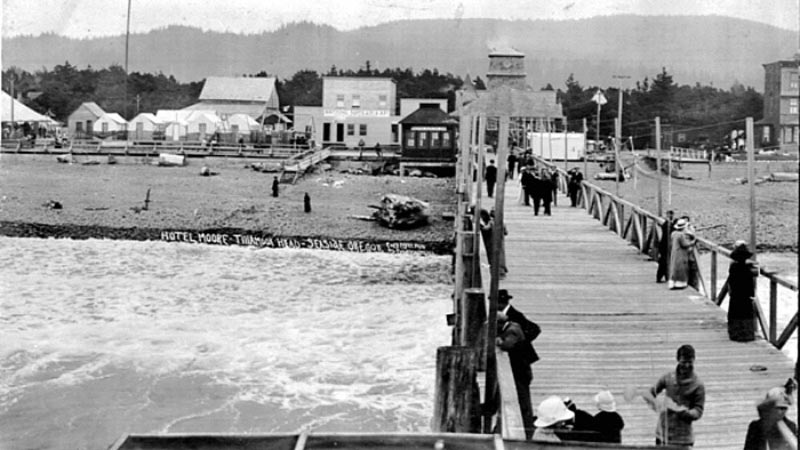Drastic Changes and Old Looks of Seaside: Oregon Coast History Part 1
Published 04/13/2020 at 5:24 PM PDT
By Oregon Coast Beach Connection staff

(Seaside, Oregon) – Perhaps more than any town along the Oregon coast, Seaside has changed the most drastically since settlers began digging in, and then turning the once thickly-populated native nation into a bustling resort. All of Clatsop Beach from here northward was actually so dramatically different 150 years ago it’s mind-boggling. (Photo above courtesy Visit Seaside / Seaside History Museum: Seaside around 1905. Below: Seaside now, showing an extra 900 feet of sand and no slope).
Here is only part one to this wild and shifting tale, which eventually involves a beach in town with loads of unmarked graves that suddenly, abruptly grew in size a mere generation ago. (Part two found at bottom)

Includes exclusive listings; some specials in winter
In Cannon Beach:
Includes rentals not listed anywhere else
In Manzanita, Wheeler, Rockaway Beach:
Some specials for winter
In Pacific City, Oceanside:
Some specials for winter
In Lincoln City:
Some specials for winter
In Depoe Bay, Gleneden Beach:
Some specials for winter
In Newport:
Look for some specials
In Waldport
Some specials for winter
In Yachats, Florence
Some specials for winter
First of all, some 800 feet or more of beach did not exist until about 100 years ago. It some places, like up around Fort Stevens and Warrenton, as much as a half mile wasn’t there.
The big change happened rather quickly in geologic terms and was caused by Man. For millennia, the place was largely the same (although ancient tsunamis were known to have shifted the river and waterways around periodically). When Lewis & Clark visited here in 1806, and the first hotel was built by railroad tycoon Ben Holladay around 1880, the cove area was much smaller, and the rest of Seaside was a beach maybe 100 feet or so from where the Prom is now. In fact, all of Seaside was essentially a fairly rocky, pebbly beach, more like what the Cove is these days.

Seaside in 1908
Look at all the early photos of Seaside in its early tourism days and you all somewhat rocky stretches, and when the wooden precursor to the Promenade was built a little after 1900 you see a plunging tideline, a bit more like the “magic rocks” beach just below Newport’s Yaquina Head or Gleneden Beach. It had a much steeper slope to it.
Now, of course, there’s some 800 to 1000 feet of sand there. Gearhart is even wider than Seaside.

The culprit of all this was the building of the jetties on the Washington coast / Oregon coast borders: on each side of the Columbia River, way up at Astoria.
Building jetties greatly increases the rate that sand flows and gets deposited. Frequently, it moves more and more into surrounding areas, which can ironically cause erosion in other places. But in the case of the Columbia River, building the jetties there - which started in the 1890's and ended by the '20s - shifted the sands in whole new ways.

Meanwhile, in 1900 Seaside’s first oceanfront hotel was built, called the Moore Hotel. Then in 1904 things got a little stupid: they built a pier jutting over the ocean – probably going halfway to where the tide is now. This, of course, lasted a whole ten years, with most winters taking out major chunks and it having to be rebuilt. They finally let it go in 1914, but they didn’t quite learn their lessons that this was the Oregon coast and not Santa Monica, building another fishing pier a ways down the beach that lasted from the mid ‘20s to the early ‘30s.
The jetties were finished in 1917 and those changes happened quickly. By the mid ‘20s, all that sand had built up from Seaside to Warrenton, and kept growing through today. Though after the ‘30s it was at a much slower rate. Now it actually may be reversing.
Part two of this tale will show a kind of alien invasion and further striking changes Seaside has seen. Part Two: Seaside's Drastic, Startling Changes: Oregon Coast History, Part Two
Hotels in Seaside - Where to eat - Seaside Maps and Virtual Tours
Cannon Beach Lodging
Nehalem Bay Lodgings
Manzanita Hotels, Lodging
Three Capes Lodging
Pacific City Hotels, Lodging
Lincoln City Lodging
Depoe Bay Lodging
Newport Lodging
Waldport Lodging
Yachats Lodging
Oregon Coast Vacation Rentals
Oregon Coast Lodging Specials
More About Oregon Coast hotels, lodging.....
More About Oregon Coast Restaurants, Dining.....
LATEST Related Oregon Coast Articles
Through 2 a.m. likely best, but some lights possible through dawn June 1 - 2. Space weather, astronomy
Rare Sperm Whale Stranding on N. Oregon Coast, Was Hit by Boat
Showing up near Gearhart, it will decompose naturally. Marine sciences
Coast Guard Barque 'America's Tall Ship' Coming to Portland Rose Fest, N. Ore...
Portland events: June 5 - 8; Astoria events June 13 - 15. Weather
hist
Back to Oregon Coast
Contact Advertise on BeachConnection.net
All Content, unless otherwise attributed, copyright BeachConnection.net Unauthorized use or publication is not permitted















































